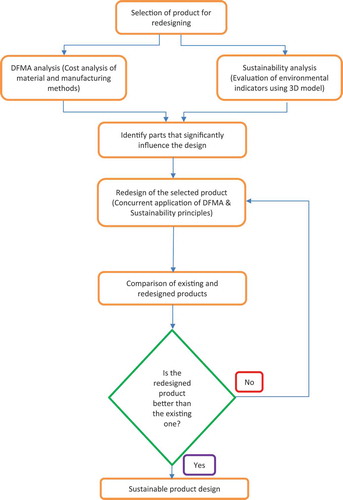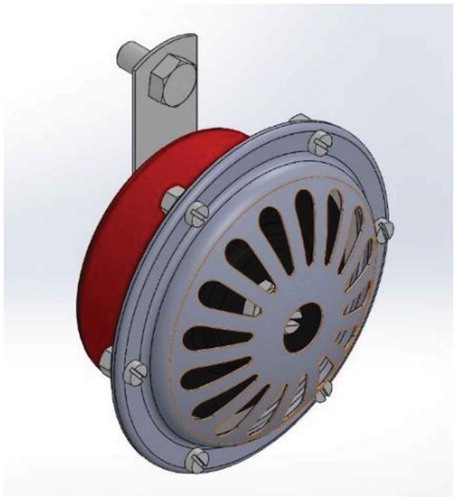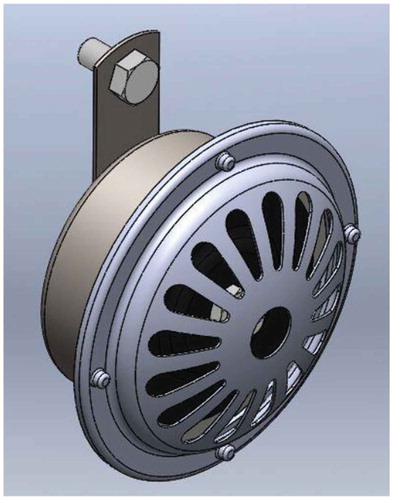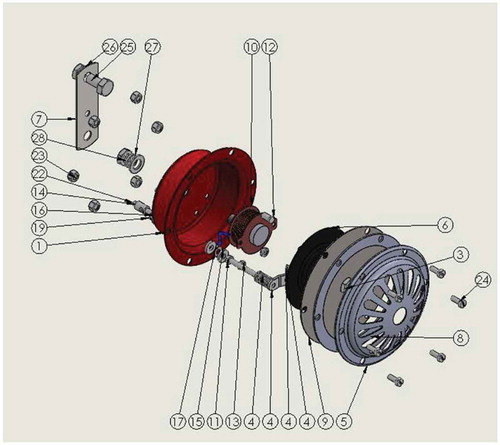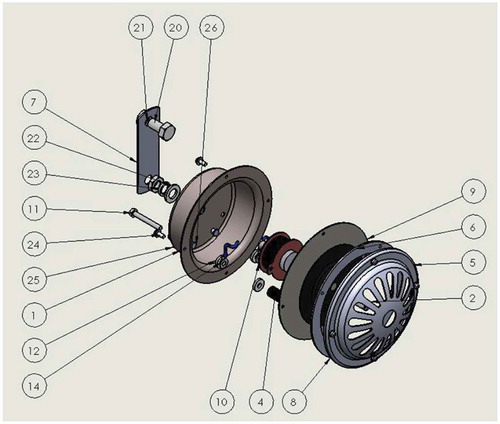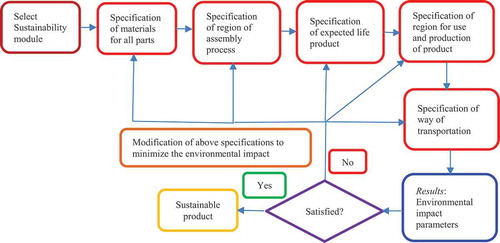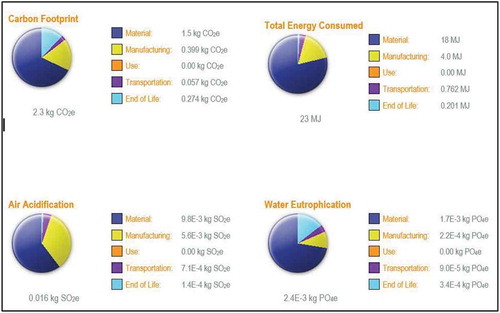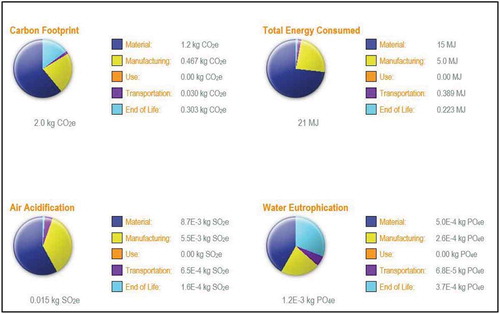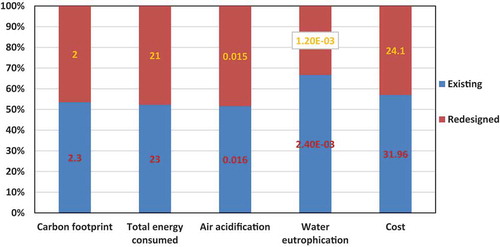ABSTRACT
In recent days, incorporation of sustainability principles in product design is gaining importance to survive and compete in the market. The goal of this work is to simultaneously apply the DFMA and sustainability principles in product design. For this purpose, a bike horn is chosen as a candidate product. The three dimensional model of an existing bike horn is created in a modelling package. The DFMA principles are applied to reduce the number of parts, cost of materials, manufacturing processes and the assembly time. The number of parts and total cost were reduced by 22.92 and 24.59%, respectively. The sustainability concepts are then applied on the product with a view to reduce its impact on the environment. It was found that, the carbon footprint and the total energy consumed were reduced by 13.04 and 8.69%, respectively. Thus, the integrated application of DFMA and sustainability concepts results in not only economical product but also eco-friendly one.
1. Introduction
Industries play a significant role in the development of nations. They enhance the quality of life by providing employment and products, which in turn benefits the society. During 18th century, the world witnessed industrial revolution, where there was an unprecedented use of natural resources with no regard for its harmful effects on the environment. As a consequence, it is now realised that a paradigm shift in the way the resources are used and disposed safely without affecting the environment, is the need of the hour. It is the only way to ensure sustainability of industries and life on the earth. The United Nations Brundtland Commission Report describes that, sustainability is linked by three components: environmental (which identifies the interdependence of life and natural resources), economic (refers to the human capital and man-made resources) and socio-political (refers to human institutions and collective decision making). For sustainable development, it is necessary for the company, organisation, corporation or industries to work in the lines of these three factors (UNESCO Citation2016; Wechsler Citation2015). For developing new products at low price and high quality by satisfying the environmental norms, it is imperative to incorporate sustainability in product design. In this context, Design for Manufacture and Assembly (DFMA) and Design for Environment (DFE) approaches enable the use of resources economically and reduce the impact on environment, respectively. This is accomplished by reducing the number of parts, number of operations, assembly and manufacturing time and selecting environmental friendly materials etc.
The objective of this paper is to illustrate product design using DFMA and sustainability approaches. For this, a case study of redesign of bike horn is chosen to exemplify the capability of integration of the above approaches. A 3D model of the bike horn is created in SOLIDWORKS modelling software and redesigned using DFMA and sustainability principles. The impact on environment is then analysed using parameters like total energy consumed, carbon footprint etc. in the same software. The originality of this work is the illustration of the integration of DFMA and sustainability for sustainable product design. The advantage of such integration results in the development of cost effective product with minimal impact on environment and enables the industries to survive in the competitive world. The structure of the paper is as follows: literature review on DFMA, DFE and sustainability; scope of work; research methodology; case study on redesign of bike horn using DFMA and sustainability approaches and results and discussion.
2. Literature review
A review of literature on DFMA, DFE and sustainability along with their definitions are presented in this section.
2.1 Design for manufacture and assembly
For several years, ‘manufacturability’ or ‘design for manufacture’ was used without any measures to quantify it. The designer must wait for the feedback from clients to improve the manufacturability. Until 1970s, no tools or techniques were available to assess the manufacturability of a component or product. The designer must be competent enough to anticipate the manufacturing problems in advance and optimise the designs to reduce the cost. The research into the automatic assembly led to the development of DFMA. A handbook containing the numerical codes for the automatic feeding and orientation methods for minor parts was published by G. Boothroyd in 1963. Later, G. Boothroyd and his graduate students hoped that they could make considerable contributions in the area of manufacturability and hence worked in the broader field of Design for Manufacture and Assembly. Thus, came the principles of DFM (Design for Manufacturing) and DFA (Design for Assembly). Dr. G. Boothroyd and Dr. P. Dewhurst were the first to work on DFMA in the early 1970s and founded Boothroyd Dewhurst Inc. in 1982. They developed a software to implement DFMA, which is presently used in many industries for optimising assembly and manufacturing operations. Ample funding was received from National Science Foundation, U.S., in mid 1970s for pursuing research in the area of DFMA. Design for Manufacturing and Assembly is thus, a blend of DFM and DFA. It can be defined as, the ease with which a product can be manufactured and assembled. The problems in assembly and manufacturing are analysed in the early design stage which could affect the final outputs. The extra time spent in the early design stage could help in significantly reducing the cost of the product. In DFM, the limitations of manufacturing process are considered in the early phase of the design. The designer is free to select materials from a huge repository of available materials and forecast the production time and cost quantitatively. All possible designs are prepared and compared. The design team then makes revisions, if needed. All these activities are carried out in the early design phase. In the next step, DFA is applied. DFA is a design methodology where the designer performs analysis, estimation, planning and simulation of the product which will ease the process of assembly in terms of time and cost. During DFA, the design could be changed several times until the assembly process is satisfied without affecting the functionality of the product (Boothroyd, Dewhurst, and Knight Citation1994; Schmidt Citation1998; Xie Citation2003).
Several researchers have applied the principle of DFMA in redesigning the product. For example, Sudin et al. (Citation2016) redesigned a dry iron by applying DFMA techniques. The number of components were reduced from 20 to 16 in the redesigned dry iron. As a result, the assembly time was reduced by 23.75% and the design efficiency was improved from 8.82% to 10.34%. Ferryanto et al. (Citation2017) implemented DFMA method to improve the design of prosthetic knee. This resulted in reduction of number of parts and assembly time. The assembly time was reduced by 36.5% and DFA index was increased by 78%. The improved prosthetic knee was then analysed for its structural integrity. The simulation results revealed that, the modified design could withstand the applied load safely without failure. Wood, Wood, and Mattson (Citation2014) modified pineapple juicers using DFMA principles. The modified juicer implementing DFMA was less expensive, clean, easy to use and easy to manufacture and assemble. Naiju, Jayakrishnan, and Warrier (Citation2017) redesigned the pedestal fan using DFMA without compromising on the quality. The total assembly time was reduced by 15.17% and the total cost the fan was reduced by 7% which proves to be a huge financial profit for the manufacturer for mass production. Barbosa and Carvalho (Citation2013) applied DFMA techniques in the design of an electrical system for a small aircraft. The following results were achieved: ease of accessibility for system installation; fewer people needed for final assembly; reduction in cycle time; ease of maintenance and troubleshooting; favoured good ergonomics and safety. Suresh, Ramabalan, and Natarajan (Citation2015) used the DFMA concept in designing the engine bracket with a view to reduce the part count and weight of the component. The number of parts were reduced by 33.33% in the redesigned one by removing unnecessary fasteners. The total weight of the product thus reduced by 39.13%. Similarly, Zivkovic and Curcic (Citation2017) demonstrated the automated application of DFMA principles in the design of wind tunnel for Military Technical Institute. Pinheiro et al. (Citation2018) applied DFMA and computer simulation approaches in the design of raincoat with thermal protection. DFMA provided a better solution, as it resulted in better productivity due to short lead time and lesser resource utilisation. In addition, it resulted in the following outcomes: reduced part counts, standardisation of parts (staples were replaced by seam and thread), and ease of assembly (Styrofoam mosaic was replaced by granules in the raincoat). Samsudin et al. (Citation2018) analysed the design of mini washing machine XPB42-688 using DFMA approach. The redesigned mini washing machine had 37 parts compared to 43 in the original design. The part count reduction is thus, 13.95%. This resulted in the improvement of design efficiency by 14.5%. Rahman et al. (Citation2019) analysed the design of baby stroller (Sweet Cherry SCR8 Series). After implementing DFMA, the assembly time was reduced by 452.29s, which is 23% less than the original design. The total number of parts reduced from 179 to 149. This led to the increase of DFA index from 9.6 to 12.6. Safaa, Hatmoko, and Purwanggono (Citation2019) analysed the use of DFMA for redesigning prefabricated bridge element. A design efficiency of 28.83%, an 8.71% reduction in the number of components and 25% ease of handling was achieved. In addition, the efficiency in assembly time improved by 51.53% and the cost was reduced by 23.39% for the redesigned bridge. Mangera et al. (Citation2019) applied DFMA technique for the design of paediatric prosthetic knee. The redesigned model was verified using finite element analysis tool. The assembly efficiency was improved by 13.6% which in turn reduced the manufacturing and labour cost. Thus, it is observed that, DFMA approach is successfully implemented in the product design process in fulfiling its objectives.
2.2 Sustainability and design for environment
The origin of sustainability dates to pre-modern times (1500–1800). The environmental problems faced during the pre-modern times and ancient civilisations are referred to as sustainability problems today. The idea of sustainability originated from the uncontrolled consumption of resources like wood, coal and oil due to population growth and industrial revolution. At the same time, the awareness about the limited availability of such resources were realised by few concerned about the environment. In addition, the economists cautioned for balancing the consumption and production to sustain the expectations of unlimited growth of economy. The focus of the designers shifted towards manufacturing products using simple technologies with minimal negative impacts on environment. The objective was to help the people of developing countries and the physically challenged ones. Several non-governmental organisations celebrated earth day to create awareness about ecological crisis. This exaggerated concerns about the safety of earth and instigated a new way of thinking about sustainable development as a substitute for unlimited growth. The consciousness about environmental safety grew in the public due to several catastrophic failures. The designers started to produce green products, which were less harmful to environment. Thus, came the words Green design and Eco-design in the scene. Eco-design addressed the impact of product on environment over its lifespan while Green design specifically on environmental impact. The responsibility of the designers, now increased to think in terms of local and global effects of their decisions while making the products (Pisani Citation2006; Knight Citation2009). Sustainability is defined in many ways which are as follows: ‘a process that empowers all persons to appreciate their latent talents and to advances the standard of living by means of which this planets life support organisation is safeguarded’ (Forum for the Future, UK as cited in Laitinen Citation2010). ‘Enhancing the standard of life within the limits of supporting ecosystems’ (UNEP, WWF, IUCN, 1991 as cited in Laitinen Citation2010). ‘In every deliberation we must consider the impact on the seventh generation’ (The Great Law of the Six Nations Iroquois Confederation as cited in UNESCO Citation2016). The Brundtland report, defines sustainability as, ‘the development that fulfils the requirements of the current without compromising the capacity of forthcoming generations to fulfil their own requirements’ (Ashrafi Citation2014). The U.S. commerce department states sustainability as, ‘the making of products from the processes that curtail negative influence on environment, preserve energy and natural reserves, which is economically sound and safe for all and’. This definition underscores the importance of products and manufacturing process in creating sustainable manufacturing goals resting on environment, economy and society which can also be referred as planet, profit and people (Giovannini et al. Citation2012).
In the framework of product design, sustainability is the design of products with minimal impact on environment, highest growth of economy and positive benefits on society. The industries must work towards designing products which could be reused, recycled and disposed safely. In addition, they must strive for minimising the intense use of materials, energy, and emissions. Thus, a paradigm shift in the product design approach was observed since from the last two decades. Earlier, product design approach incorporating environmental considerations was referred to as green design. Later the terms like eco-design, that is, environmentally friendly design (widely used in Europe) or DfE (Design for Environment, widely used in U.S.) were used. Both eco-design and DfE are restricted to reducing the environmental impacts. DfE incorporated the environmental issues in one of stage of product’s life cycle while eco-design’s scope is stretched over the entire product’s life cycle. Currently, the term sustainable design is used and accepted all over the world. Sustainable design integrates the environment, economy and societal parameters into the design and development of products (Baumann, Boons, and Bragd Citation2002).
A variety of eco-design tools are available ranging from a simple one to intricate, quantitative and tedious tools. A few of them perform intensive calculations to quantify the sustainability and provide measures to enhance the product’s performance towards sustainability. Simple tools are used to perform primary qualitative analysis from which suggestions are presented to improve the design of the product (Ahmad et al. Citation2018). Several authors classified these eco-design tools in different ways. Baumann, Boons, and Bragd (Citation2002) categorised the eco-design tools into 6 groups: frameworks, checklists and guidelines, rating and ranking approaches, analytical tools, software and expert systems, and organising methods. Similarly, Kim and Moon (Citation2017) categorised them into 4 groups: guidelines/standards, checklists, comparative tools and analytical methods. Devanathan et al. (Citation2010) classified 30 eco-design tools into 3 groups: life cycle assessment (LCA) based tools, checklist-based tools, and quality function deployment (QFD) based tools. Whereas Knight and Jenkins (Citation2009) formed 3 categories: guidelines, checklists and analytical tools. Pardo et al. (Citation2011) presented a usage-oriented classification of eco-design tools. They are: Complex, medium-level complex and low-level complex tools. Poulikidou (Citation2012) classified based on their quantitative or qualitative nature of methodology. The shift between Qualitative and Quantitative methods are classified into 4 major groups; fully qualitative, semi-quantitative, qualitative/quantitative and fully quantitative methods and tools. Qualitative methods need the qualitative information or input data. Semi-quantitative methods provide quantitative outcome based on the qualitative input data. Qualitative/Quantitative methods need inputs based on various criteria and result include qualitative and quantitative score for each criterion. Fully quantitative methods need quantitative data as inputs to tool (Midžić, Štorga, and Marjanović Citation2015). For more details of the above tools mentioned in this section can be found in the respective references, as the discussion of these tools is beyond the scope of this paper.
Several authors have worked on implementing the concept of sustainability in product design. A few of the important case studies are as follows: Bovea and Vidal (Citation2004) proposed a method of materials selection to enhance sustainability of wood-based furniture design. The life cycle analysis technique was applied for wood-based boards, surface and edge coverings and the corresponding manufacturing processes. A standard low particle board instead of standard fibreboard and a low-density laminate instead of high density one and surface-edge coverings were chosen for the board due to their minimal impact on environment. Lacasa et al. (Citation2015) implemented the criteria of sustainability in the design of solar trackers for low power requirements and airbrush for precision works. The amount of material, energy and processing time were reduced. This in turn reduces energy consumed and global warming. By reducing the total mass of the product by 40%, a reduction of 20% of eco-design indicators were accomplished for the cases of solar tracker and airbrush design. Suresh, Ramabalan, and Natarajan (Citation2015) incorporated sustainability principle in the design of a connecting rod. By minimising its weight by 35%, the impact on the environment was reduced by 25%. Suresh, Ramabalan, and Natarajan (Citation2016) applied the sustainable concept in the design of single component viz., pulley, which will have minimal impact on environment. The impact on the environment was reduced to 45% using sustainable design approach. Fatima, Effendi, and Rosli (Citation2018) incorporated DFMA and sustainability approaches for the design of angle grinder. As a consequence, the design efficiency improved to nearly 22%. By changing only the materials few parts in the sustainability analysis, the environmental impact indicator reduced to 15%. Zhafri, Effendi, and Rosli (Citation2018) analysed the drone components using DFMA and sustainability approaches with a view to reduce the number of components and its impact on environment. By applying DFMA, the design was modified to reduce the number of components to 38% and weight to 30%. As result, the impact on the environment reduced to around 30%. Similarly, Antony and Arunkumar (Citation2020) applied the principles of DFMA and sustainability for design of a chair. By incorporating suitable design changes, the part count was reduced from 36 to 9, (75% reduction) and the impact on the environment was thus decreased to nearly 50%. Similar works can be found in Azri, Effendi, and Rosli (Citation2018), Chowdary, Richards, and Gokool (Citation2019), Sharma et al. (Citation2019) and Deepak, Parhi, and Jena (Citation2019).
3. Scope of work and research methodology
It is observed from the above literature review that, many authors have worked on the implementation of DFMA, DFE and sustainability principles separately in product design. Limited number of authors attempted in the simultaneous application of DFMA, DFE and sustainability using geometric modelling. When these principles are implemented in the early design stage using computer-aided modelling, it allows the estimation of impacts of product on the environment. Thus, the integration of DFMA, DFE and sustainability concepts in the design or redesign of products helps in the reducing the costs of manufacturing and assembly and harmful effects on environment. Further investigations in this direction concurrently incorporating the above principles in product design is very much essential for developing efficient design tools, which ensure environmental-friendly products. In this context, this work aims at implementing DFMA and sustainability concepts simultaneously in the redesign of a bike horn and its implications on cost and environmental indicators.
The research methodology employed in this work is illustrated in . This work begins with a brief introduction, literature review on DFMA, DFE and sustainability concepts. A candidate product, viz., bike horn is selected in the next step for performing the analysis. The objective is to identify the components that significantly affect the cost and environment based on the cost estimates from DFMA and environmental indicators of sustainability analysis. To accomplish this, a 3D model of the product was created in SOLIDWORKS software. The costs of material and manufacturing methods and the environmental impact parameters were obtained from the same software. The product is then redesigned, in such a way that both the cost and harmful effects on the environment are minimised in comparison to the original product. This step is an iterative one and the final redesigned version of the product is presented in this work. Finally, a sustainable product arrives out of this methodology.
5. Case study – sustainable design of bike horn (Jawa-CZ Kyvacka)
The candidate product selected for the case study of DFMA and sustainability analysis is the Jawa-CZ Kyvacka bike horn. A brief description of the candidate product is as follows: Horn is a sound-signalling device used for alerting the people and for safe driving. It basically consists of an electromagnet, contact plates, plunger, diaphragm (a thin metallic sheet or membrane which vibrates for producing sound) and a cup. Using several fasteners these elements are assembled within the cup in position. On pressing the horn, current flows through the electromagnet. This magnetises the electromagnet and pulls the plunger, which is connected to the diaphragm. As a result, the diaphragm moves inside along with the plunger. The contact breaker located in the plunger stops the current momentarily. This permits the diaphragm to move to its original position. The current is then restored and this cycle is continued until the horn is pressed. The swift movement of the diaphragm or its quick vibrations, produces the sound. This is the working principle of an electromagnetic horn, chosen in this work.
4.1 DFMA analysis of bike horn
With a view to improve the design, the original horn design was modified by applying Boothroyd and Dewhurst method of DFMA, where the number of parts and hence, the assembly time were reduced. A 3D model of the horn was created in SOLIDWORKS software. The 3D model and the exploded view of the original and modified bike horn is shown in . The description of part numbers and their functions (as given in and ) are explained in and respectively. In addition, and give the list of parts, material and manufacturing costs of the original and modified horn design.
Table 1. Material and Manufacturing costs of Original horn assembly before implementing DFMA ()
Table 2. Material and Manufacturing costs of Redesigned horn assembly after implementing DFMA ()
4.1.1 DFM and DFA of bike horn
Without affecting the functionality of the mechanism, the horn design was modified. The salient design modifications implemented in the horn are: reduction in the number of fasteners, removal of unnecessary parts, design changes to selected part. As a result, the weight of the assembly is reduced by small amount. The design modifications implemented the parts of the horn are given . The fool proof pin is eliminated, as there is no need to guide the product to be in a particular angle and can be rotated as per the requirement or convenience. The nuts connecting the body and grill are eliminated; instead few plastic extrusions can be made to fit the screws. The bolts of the product are changed to screws and the quantity is reduced from 6 to 4 by ensuring the same fitness as before. The total parts are thus reduced from 48 to 37. The electric insulator design is changed to reduce the amount of material to 39.3%. The electric power connector is changed from the existing to pin type for easy snap and fit for the wire instead of using a tool to tighten the wire. With these design modifications, certainly assembly time will be reduced significantly. The material and manufacturing costs were obtained from the costing module of SOLIDWORKS software before and after implementing DFMA. As a consequence, the material cost, manufacturing cost and total costs were reduced by 7.52, 33.94 and 24.59%, respectively, after the implementation of DFM.
Table 3. Recommended modifications of the design applied using DFMA
4.2 Sustainability analysis of bike horn
The sustainability analysis of the original and redesigned horn was carried out in the sustainability module of SOLIDWORKS software. This module helps in analysing the imprint of the design left on the environment. It is very important to understand the significance of natural resources and the impact of products on the nature. Although this is hard, it is the need of the hour. In this context, the sustainability module of SOLIDWORKS software helps in quantitative understanding of the environmental impact of products simultaneously with the design process. Sustainable design aims at assessing the four environmental factors: Carbon footprint, Air acidification, Water eutrophication and Total energy consumed. The inputs to this module are the geometric model, materials, manufacturing process and locations of manufacture and distribution. The outputs are available on the Environmental Impact Menu of sustainability module and can be updated dynamically (Luminita and Popa Citation2017). Some of the techniques adopted to enhance the sustainability the product are reducing the number of parts, changing the manufacturing and assembly method, selection of less hazardous materials etc. (Yang et al. Citation2017).
The 3D geometric model of the bike horn, materials and manufacturing processes were given as input. Since the local locations were not available in the software, it was assumed that (for analysis purpose) assembly process carried out in Asia and the product to be used in North America. The shipping distance is 1.2 × 104 km. The life of the horn is 1 year. From the ‘Materials tab’, the material of the grill is changed to recycle plastic. Similarly, the ‘Manufacturing tab’, the manufacturing process of the horn body changed to die casting. Finally, the environmental indicators were evaluated from the sustainability module. The flow chart of the working of sustainability module of SOLIDWORKS software is shown in .
The sustainability aspects included in the horn design along with DFMA are shown in . By changing the manufacturing process, the painting of the horn body is eliminated, since the process gives very good surface finish. Thus, the cost of painting is reduced. The grill of the body is to protect the inner parts of the horn from the dust and dirt. Changing the material from stainless steel to recycled plastic makes no change to the design and also increases the sustainability of the product by reusing the waste.
Table 4. Modifications in design for improving the Sustainability
6. Results and discussion
The application of DFMA on the original bike horn reduced the number of parts from 48 to 37 that is, 22.92% which is very much significant. In addition, the cost of materials and manufacturing processes reduced from USD 11.31 to USD 10.46 (7.52% reduction) and USD 20.65 to USD 13.64 (33.94% reduction) respectively. As a consequence, the total cost of the bike horn was reduced by 24.59%. In the next step, the impact of original and modified bike horn designs on the environment were obtained from the sustainability module of SOLIDWORKS software. The environmental indicators are in terms of carbon footprint, total energy consumed (material, manufacturing, transportation, use and end of life), air acidification and water eutrophication ( and ). The effect of redesign by reducing the number of parts and incorporating eco-friendly materials and processes can be observed in . From Table 5, it can be noticed that, a reduction of carbon footprint by 13.04%, the total energy by 8.69%, air acidification by 6.25% and water eutrophication by 50% were achieved. The environmental impact comparison of original and redesigned horn across different life cycle phases is given in . In addition, the comparison of cost and environmental impact parameters is also presented graphically in . An appreciable reduction in the harmful effect of on the environment is accomplished through the integrated application of DFMA and sustainability principles resulting in an environmentally friendly and economical design.
Table 5. Impact assessment of the Original design and Redesigned horn.
Table 6. Environmental impact comparison of Original design and Redesigned bike horn over different life cycle phases
5.1 Industrial implications
The principles of DFMA and sustainability is gaining importance among industries to ensure productivity, economical use of resources and minimise the harmful effect on the environment. DFMA in particular provides guideline for reducing the number of parts through standardisation, selection of economical material without compromising the integrity of product and modification of design to reduce the assembly time. This results in the reduction of total cost of the product. However, part consolidation alone is not sufficient to survive in this competitive market, since the industries are required satisfy the environmental norms set by the local government. Hence, it is obligatory to integrate DFMA and sustainability concept in the early phases of product design. This case study has clearly illustrated the simultaneous application of DFMA and sustainability principles through the redesign of bike horn. The results indicated that the total cost the redesigned product and its harmful effect on the environment reduced significantly. These type of case studies must be carried out in large number to arrive at an optimised design tool or a frame work of integrated application of DFMA and sustainability, so that the designers can quickly pull out this guideline and implement it in the product design.
6. Conclusions
In this work, DFMA and sustainability concepts are applied simultaneously in redesigning the bike horn. Following are the outcomes of this case study.
The number of parts, material, manufacturing and total costs were reduced by 22.92, 7.52, 33.94 and 24.59%, respectively, after incorporating DFMA in the redesigned bike horn. The number of fasteners have been reduced and replaced by snap fit. As a consequence, the assembly time reduces considerably.
By selecting suitable materials and manufacturing processes, the harmful effect on the environment is reduced significantly. The sustainability analysis of the redesigned horn, indicated that the carbon footprint, the total energy consumed, air acidification and water eutrophication were reduced by 13.04, 8.69, 6.25 and 50%, respectively.
Thus, the integrated application of DFMA and sustainability in product design not only reduces the cost but also helps in manufacturing environmental friendly products.
Disclosure statement
No potential conflict of interest was reported by the authors.
Additional information
Notes on contributors
Arunkumar Subbaiah
Dr. Arunkumar Subbaiah, currently serves as assistant professor in the department of Mechanical Engineering at Amrita Vishwa Vidyapeetham. He received his PhD from IIT Madras. During his PhD, he performed various experiments like high cycle fatigue, high temperature fatigue (both HCF and LCF), high temperature corrosion fatigue using MTS servo hydraulic testing machine (100kN capacity). Presently, at Amrita Vishwa Vidyapeetham, he teaches design related subjects such as fracture mechanics, mechanical vibrations, numerical methods, pressure vessel design, engineering mechanics, finite element methods and materials testing laboratory. He has published papers in various international journals and conferences.
Kishore M. Antony
Kishore M. Antony is a graduate student in the department of Mechanical Engineering at Amrita Vishwa Vidyapeetham. His areas of interest are DFMA, finite element analysis.
References
- Ahmad, S., K. Y. Wong, M. L. Tseng, and W. P. Wong. 2018. “Sustainable product design and development: A review of tools, applications and research prospects.” Resources, Conservation and Recycling 132: 49–61. doi:10.1016/j.resconrec.2018.01.020.
- Antony, K. M., and S. Arunkumar. 2020. “DFMA and sustainability in product design.” IOP Conference Series: Journal of Physics: Conference Series 1455: 012028. doi:10.1088/1742-6596/1455/1/012028.
- Ashrafi, N. 2014. “A Review of Current Trend in Design for Sustainable Manufacturing.” IOSR Journal of Mechanical and Civil Engineering 11 (4): 53–58. doi:10.9790/1684-11425358.
- Azri, N. M., M. S. M. Effendi, and M. F. Rosli. 2018. “Preliminary studies on DFMA and sustainable design approach: A case study on a cordless drill.” AIP Conference Proceedings 2030 (1): 020069. doi:10.1063/1.5066710.
- Barbosa, G. F., and J. Carvalho. 2013. “Design for Manufacturing and Assembly methodology applied to aircrafts design and manufacturing.” 11th IFAC workshop on Intelligent Manufacturing Systems, The International Federation of Automatic Control, May 22-24, Sao Paulo, Brazil.
- Baumann, H., F. Boons, and A. Bragd. 2002. “Mapping the green product development field: Engineering, policy and business perspectives.” Journal of Cleaner Production 10 (5): 409–425. doi:10.1016/S0959-6526(02)00015-X.
- Boothroyd, G., P. Dewhurst, and W. Knight. 1994. Product Design for Manufacture and Assembly. CRC Press, Taylor and Francis Group: Marcel Dekker.
- Bovea, M. D., and R. Vidal. 2004. “Materials selection for sustainable product design: A case study of wood based furniture eco-design.” Materials and Design 25 (2): 111–116. doi:10.1016/j.matdes.2003.09.018.
- Chowdary, B. V., M. Richards, and T. Gokool. 2019. “An integrated approach of sustainable product design: Concurrent application of DFMA, DFE and CAD/CAE principles and tools.” Latin American Journal of Management for Sustainable Development 4 (4): 259–275. doi:10.1504/LAJMSD.2019.100836.
- Deepak, B. B. V. L., D. R. K. Parhi, and P. C. Jena. 2019. “Select proceedings of First International Conference on Innovative product design and intelligent manufacturing systems.” In Lecture Notes in Mechanical Engineering, 1–1049. Singapore: Springer. doi: 10.1007/978-981-15-2696-1.
- Devanathan, S., D. Ramanujan, W. Z. Bernstein, F. Zhao, and K. Ramani. 2010. “Integration of sustainability into early design through the function impact matrix.” Journal of Mechanical Design 132 (81004): 1–8. doi:10.1115/1.4001890.
- Fatima, S. B. A., M. S. M. Effendi, and M. F. Rosli 2018. “An integration between sustainability and design for manufacturing and assembly (DFMA) analysis for angle grinder.” AIP Conference Proceedings 2030 (1): 020073. doi:10.1063/1.5066714.
- Ferryanto, F., K. A. Muhammad, T. Rubiyanto, S. Mihradi, and A. I. Mahyuddin. 2017. “Design Modification of an Affordable Prosthetic Knee Based on DFMA and Static Analysis.” 5th International Conference on Instrumentation, Communications, Information Technology, and Biomedical Engineering ( ICICI-BME) Bandung. doi:10.1109/ICICI-BME.2017.8537726.
- Giovannini, A., A. Aubry, H. Panetto, M. Dassisti, and H. El Haouzi. 2012. “Ontology-based system for supporting manufacturing sustainability.” Annual Reviews in Control 36 (2): 309–317. doi:10.1016/j.arcontrol.2012.09.012.
- Kim, S., and S. K. Moon. 2017. “Sustainable platform identification for product family design.” Journal of Cleaner Production 143: 567–581. doi:10.1016/j.jclepro.2016.12.073.
- Knight, A. 2009. “Hidden Histories: The story of sustainable design.” Proquest, 1–17. https://doi.org/10.1.1.489.4236.
- Knight, P., and J. O. Jenkins. 2009. “Adopting and applying eco-design techniques: A practitioner’s perspective.” Journal of Cleaner Production 17: 549–558. doi:10.1016/j.jclepro.2008.10.002.
- Lacasa, E., J. L. Santolaya, L. Fuentes, and A. C. Majarena. 2015. “Implementing sustainability criteria in product development.” Procedia Engineering 132: 1029–1036. doi:10.1016/j.proeng.2015.12.592.
- Laitinen, J. 2010. “Sustainable development and the Earth Charter.” http://www.slideshare.net/EarthCharter/sustainable-development-and-the-earth-charter
- Luminita, I. P., and V. N. Popa. 2017. “Products eco-sustainability analysis using CAD SolidWorks software.” MATEC Web of Conferences 112: 06002. doi:10.1051/matecconf/201711206002.
- Mangera, T., F. Kienhofer, K. Carlson, M. Conning, T. Pukis, and G. Govender. 2019. “Design for Manufacture and Assembly of a polycentric paediatric prosthetic knee.” Proceedings of the Institution of Mechanical Engineers, Part B: Journal of Engineering Manufacture 233 (14): 2566–2576. doi:10.1177/0954405419840555.
- Midžić, I., M. Štorga, and D. Marjanović. 2015. “Eco-Evaluation in Conceptual Design phase - A Case Study.” Transactions of Famena XXXIX-3: 47–60. https://hrcak.srce.hr/148556
- Naiju, C. D., V. Jayakrishnan, and P. V. Warrier. 2017. “DFMA for early cost estimation of pedestal fan: A case study.” Journal of Industrial and Intelligent Information 1–4. doi:10.18178/jiii.5.1.
- Pardo, H. R. J., D. Brissaud, F. Mathieux, and P. Zwolinski. 2011. “Contribution to the characterisation of eco-design projects.” International Journal of Sustainable Engineering 4 (4): 301–312. doi:10.1080/19397038.2011.560293.
- Pinheiro, N. M. G., R. E. C. Ordonez, G. L. L. Barbosa, and F. G. Dedini. 2018. “Computational simulation applied in choosing the best solution in a product development using Design for Manufacturing and Assembly approach.” Brazilian Journal of Operations and Production Management 15 (4): 618–628. doi:10.14488/BJOPM.2018.v15.n4.a15.
- Pisani, J. A. D. 2006. “Sustainable development – Historical roots of the concept.” Environmental Sciences 3 (2): 83–96. doi:10.1080/15693430600688831.
- Poulikidou, S. 2012. “Methods and Tools for Environmentally Friendly Product Design and Development, Identification of their Relevance to the Vehicle Design Context, Division of Environmental Strategies Research‐fms.” KTH Royal Institute of Technology, Stockholm. https://www.diva-portal.org/smash/get/diva2:550522/FULLTEXT01.pdf
- Rahman, M. H. A., N. A. Maidin, M. N. Ahmad, M. H. Osman, M. K. Wahid, and A. N. M. Ruslan. 2019. “Design for Manufacture and Assembly analysis of baby stroller.” Journal of Advanced Manufacturing Technolgoy 61–67. eISSN: 2289-8107; Special Issue iDECON 2016.
- Safaa, Y. P., J. U. D. Hatmoko, and B. Purwanggono. 2019. “Evaluation of the use of prefabricated bridge elements with Design for Manufacture and Assembly (DFMA) criteria.” MATEC Web of Conferences 270: 05006. doi:10.1051/matecconf/201927005006.
- Samsudin, H. A., M. F. Rosli, M. S. M. Effendi, and M. H. Abdullah 2018. “DFMA: Analysis on mini washing machine XPB42-688.” AIP Conference Proceedings 2030 (1): 020138. doi:10.1063/1.5066779.
- Schmidt, S. 1998. “Preventive Optimisation of Costs and Quality for the Total Life Cycle - Design for Manufacture, Assembly, Service, Environment (DFMA).” Total Life Cycle Conference Proceedings, SAE International, Geneva, 1–9. doi:10.4271/982166.
- Sharma, J. K., A. Rajeshkannan, A. A. Sharma, and D. R. Seenivasagam. 2019. “Some aspects on the sustainable process design in a timber mill using the design for manufacturability/sustainability.” International Journal of Sustainable Engineering. doi:10.1080/19397038.2019.1674941.
- Sudin, M. N., N. S. Chin, S. A. Shamsudin, and M. A. Yusuff. 2016. “Design efficiency analysis towards product improvement for Eco-friendly using DFMA method.” The Open Mechanical Engineering Journal 10 (1): 173–181. doi:10.2174/1874155X01610010173.
- Suresh, P., S. Ramabalan, and U. Natarajan. 2015. “Product development in automotive component using Design for Manufacturing and Assembly (DFMA).” In Advanced Engineering Research and Applications, 183–191. Research India Publications.
- Suresh, P., S. Ramabalan, and U. Natarajan. 2016. “Integration of DFE and DFMA for the sustainable development of an automotive component.” International Journal of Sustainable Engineering 9 (2): 107–118. doi:10.1080/19397038.2015.1096313.
- UNESCO. 2016. “Introduction to Sustainability.” https://static1.squarespace.com/static/552e4b07e4b0d43bb9fe3f42/t/5a9ea3ecc83025ca5dd5a375/1520346098044/1.2+Introduction+to+Sustainability.pdf
- Wechsler, J. 2015. “The End of Unsustainable Design, Misc Magazine: The reset issue.” https://medium.com/@jacwex/the-end-of-unsustainable-design-140a6e1516ec
- Wood, A. E., C. D. Wood, and C. A. Mattson. 2014. “Application and modification of design for manufacture and assembly principles for the developing world.” IEEE Global Humanitarian Technology Conference, Silicon Valley/San Jose, California, USA, 451–457. doi:10.1109/GHTC.2014.6970321.
- Xie, X. 2003. “Design for Manufacture and Assembly.” Corpus ID: 17837244. https://www.semanticscholar.org/paper/Design-for-Manufacture-and-Assembly-Xie/2889e78a24d3ce8d0f219f99acd1d891a565b242
- Yang, S., T. Talekar, M. A. Sulthan, and Y. F. Zhao. 2017. “A generic sustainability assessment model towards consolidated parts fabricated by additive manufacturing methods.” Procedia Manufacturing 10: 831–844. doi:10.1016/j.promfg.2017.07.086.
- Zhafri, Z. M., M. S. M. Effendi, and M. F. Rosli. 2018. “Optimization of assembly process and environment impact using DFMA and sustainable design analysis: Case study of drone.” AIP Conference Proceedings 2030: 020074. doi:10.1063/1.5066715.
- Zivkovic, S., and Curcic. 2017. “Applying the DFMA techniques in the design and manufacture of wind tunnel models.” International Journal of Advanced Quality 45: 35–40. doi:10.25137/IJAQ.n1.v45.y2017.

